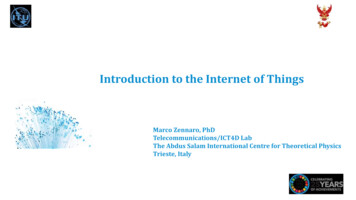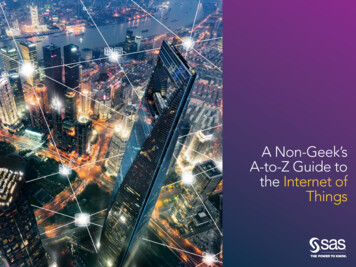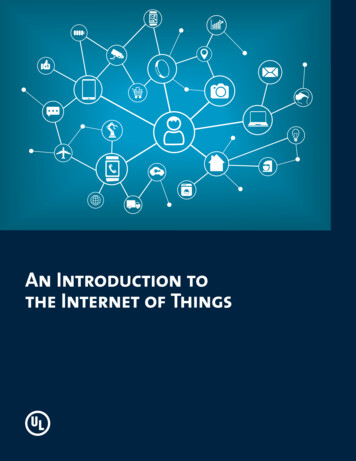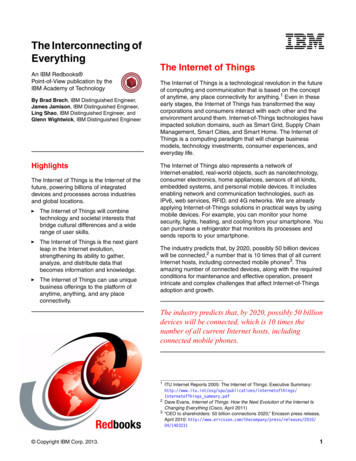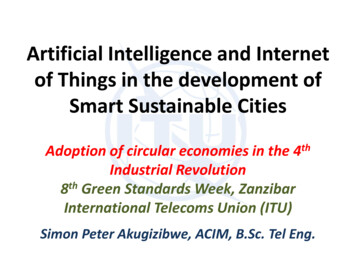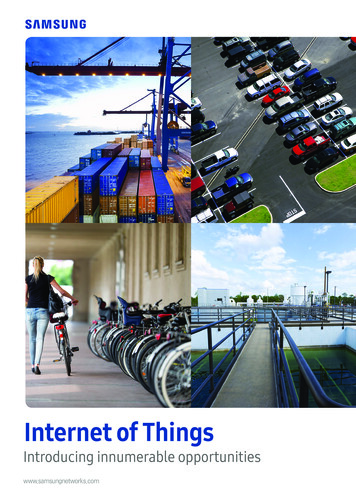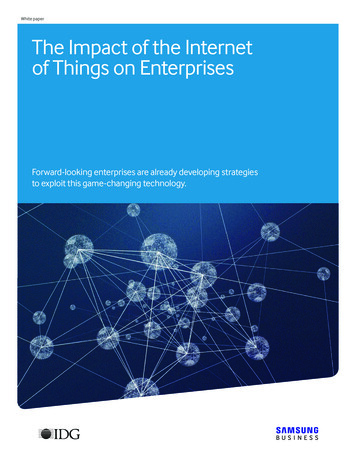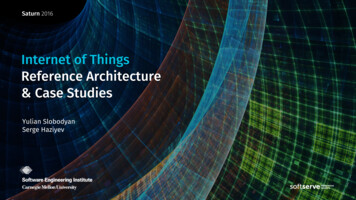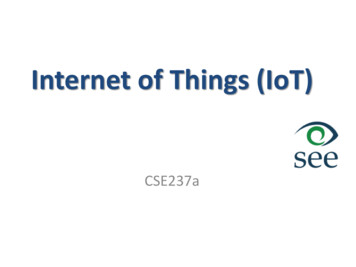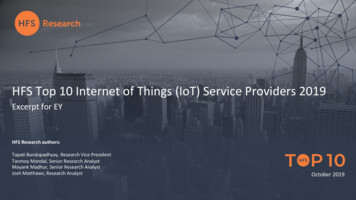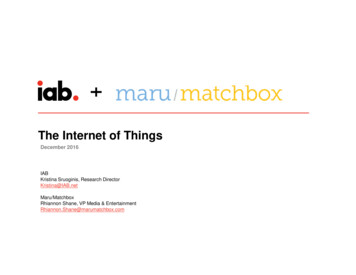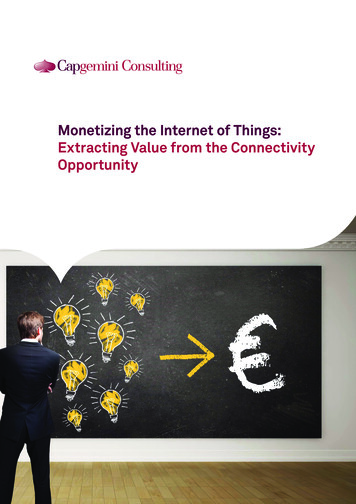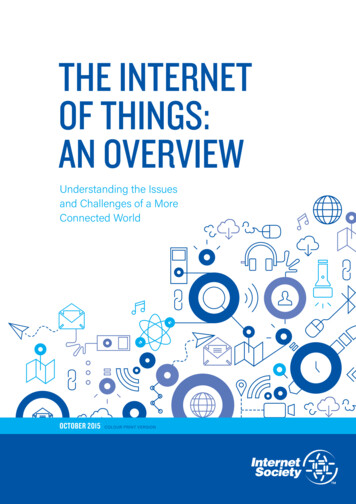
Transcription
THE INTERNETOF THINGS:AN OVERVIEWUnderstanding the Issuesand Challenges of a MoreConnected WorldOCTOBER 2015COLOUR PRINT VERSION
THE INTERNETOF THINGS:AN OVERVIEWUnderstanding the Issuesand Challenges of a MoreConnected WorldKaren Rose, Scott Eldridge, Lyman ChapinOCTOBER 2015COLOUR PRINT VERSION 2015 The Internet Society (ISOC).This work is licensed under the Creative CommonsAttribution/NonCommercial/ShareAlike 4.0 Unported license.
CONTENTSExecutive Summary. 4Introduction. 8WHAT IS THEINTERNET OF THINGS?11Origins, Drivers and Applications. 12Different Definitions, Similar Concepts. 16Internet of Things Communications Models. 18Device-To-Device Communications18Device-To-Cloud Communications19Device-to-Gateway Model20Back-End Data-Sharing Model22Internet of Things Communications Models Summary23WHAT ISSUES ARE RAISEDBY THE INTERNET OF THINGS?27Security Issues. 31The IoT Security Challenge32A Spectrum of Security Considerations33Unique Security Challenges of IoT Devices34IoT Security Questions35Privacy Considerations. 39Internet of Things Privacy Background40Unique Privacy Aspects of Internet of Things41IoT Privacy Questions422
Interoperability/ Standards Issues. 45IoT Interoperability / Standards Background46Key Considerations and Challenges in IoT Interoperability / Standards47Interoperability Questions50Legal, Regulatory, and Rights Issues. 53Data Protection and Crossborder Data Flows54IoT Data Discrimination55IoT Devices as Aids to Law Enforcement and Public Safety56IoT Device Liability57Proliferation of IoT Devices Used in Legal Actions58Regulatory, Legal, and Rights Issues Summary58Emerging Economy and Development Issues. 61Ensuring IoT Opportunities are Global62Economic and Development Opportunities62IoT Emerging Economy and Development Questions64CONCLUSION67FOR FURTHER INFORMATION71Organizations and Alliances Working on the Internet of Things72Government Policy, Research, and Coordination Efforts74Notes and Acknowledgements753
Executive SummaryEXECUTIVE SUMMARYThe Internet of Things is an emerging topic oftechnical, social, and economic significance.Consumer products, durable goods, cars and trucks,industrial and utility components, sensors, and othereveryday objects are being combined with Internetconnectivity and powerful data analytic capabilities that promiseto transform the way we work, live, and play. Projections for theimpact of IoT on the Internet and economy are impressive, withsome anticipating as many as 100 billion connected IoT devicesand a global economic impact of more than 11 trillion by 2025.At the same time, however, the Internet of Things raisessignificant challenges that could stand in the way of realizingits potential benefits. News headlines about the hackingof Internet-connected devices, surveillance concerns, andprivacy fears already have captured public attention. Technicalchallenges remain and new policy, legal and developmentchallenges are emerging.This overview document is designed to help the Internet Societycommunity navigate the dialogue surrounding the Internet ofThings in light of the competing predictions about its promisesand perils. The Internet of Things engages a broad set of ideasthat are complex and intertwined from different perspectives.4
The Internet Of Things: An OverviewKey concepts that serve as a foundation for exploring theopportunities and challenges of IoT include:IOT DEFINITIONSThe term Internet of Things generally refers to scenarios wherenetwork connectivity and computing capability extends toobjects, sensors and everyday items not normally consideredcomputers, allowing these devices to generate, exchangeand consume data with minimal human intervention. There is,however, no single, universal definition.ENABLINGTECHNOLOGIESThe concept of combining computers, sensors, and networksto monitor and control devices has existed for decades. Therecent confluence of several technology market trends, however,is bringing the Internet of Things closer to widespread reality.These include Ubiquitous Connectivity, Widespread Adoptionof IP-based Networking, Computing Economics, Miniaturization,Advances in Data Analytics, and the Rise of Cloud Computing.CONNECTIVITYMODELSIoT implementations use different technical communicationsmodels, each with its own characteristics. Four commoncommunications models described by the Internet ArchitectureBoard include: Device-to-Device, Device-to-Cloud, Device-toGateway, and Back-End Data-Sharing. These models highlightthe flexibility in the ways that IoT devices can connect andprovide value to the user.TRANSFORMATIONALPOTENTIALIf the projections and trends towards IoT become reality, it mayforce a shift in thinking about the implications and issues in aworld where the most common interaction with the Internetcomes from passive engagement with connected objects ratherthan active engagement with content. The potential realizationof this outcome—a “hyperconnected world”—is testament tothe general-purpose nature of the Internet architecture itself,which does not place inherent limitations on the applications orservices that can make use of the technology.5
Executive SummaryFive key IoT issue areas are examined to explore some ofthe most pressing challenges and questions related to thetechnology. These include security; privacy; interoperabilityand standards; legal, regulatory, and rights; and emergingeconomies and development.SECURITYand resilience of the Internet globally. Thischallenge is amplified by other considerationslike the mass-scale deployment of homogenousIoT devices, the ability of some devices toautomatically connect to other devices, and thelikelihood of fielding these devices in unsecureenvironments.While security considerations are not new in thecontext of information technology, the attributesof many IoT implementations present new andunique security challenges. Addressing thesechallenges and ensuring security in IoT productsand services must be a fundamental priority.Users need to trust that IoT devices and relateddata services are secure from vulnerabilities,especially as this technology become morepervasive and integrated into our daily lives.Poorly secured IoT devices and services canserve as potential entry points for cyber attackand expose user data to theft by leaving datastreams inadequately protected.As a matter of principle, developers and usersof IoT devices and systems have a collectiveobligation to ensure they do not expose users andthe Internet itself to potential harm. Accordingly, acollaborative approach to security will be neededto develop effective and appropriate solutions toIoT security challenges that are well suited to thescale and complexity of the issues.The interconnected nature of IoT devicesmeans that every poorly secured device that isconnected online potentially affects the securityPRIVACYused, and protected. For example, IoT amplifiesconcerns about the potential for increasedsurveillance and tracking, difficulty in beingable to opt out of certain data collection, andthe strength of aggregating IoT data streamsto paint detailed digital portraits of users.While these are important challenges, theyare not insurmountable. In order to realizethe opportunities, strategies will need to bedeveloped to respect individual privacy choicesacross a broad spectrum of expectations, whilestill fostering innovation in new technologyand services.The full potential of the Internet of Thingsdepends on strategies that respect individualprivacy choices across a broad spectrumof expectations. The data streams and userspecificity afforded by IoT devices can unlockincredible and unique value to IoT users, butconcerns about privacy and potential harmsmight hold back full adoption of the Internetof Things. This means that privacy rights andrespect for user privacy expectations are integralto ensuring user trust and confidence in theInternet, connected devices, and related services.Indeed, the Internet of Things is redefiningthe debate about privacy issues, as manyimplementations can dramatically changethe ways personal data is collected, analyzed,6
The Internet Of Things: An OverviewINTEROPERABILITY / STANDARDSthe networking resources they connect to andthe broader Internet. Appropriate standards,reference models, and best practices also willhelp curb the proliferation of devices that mayact in disrupted ways to the Internet. The use ofgeneric, open, and widely available standardsas technical building blocks for IoT devices andservices (such as the Internet Protocol) willsupport greater user benefits, innovation, andeconomic opportunity.A fragmented environment of proprietary IoTtechnical implementations will inhibit value forusers and industry. While full interoperabilityacross products and services is not alwaysfeasible or necessary, purchasers may behesitant to buy IoT products and services ifthere is integration inflexibility, high ownershipcomplexity, and concern over vendor lock-in.In addition, poorly designed and configured IoTdevices may have negative consequences forLEGAL, REGULATORY, AND RIGHTSThe use of IoT devices raises many newregulatory and legal questions as well asamplifies existing legal issues around the Internet.The questions are wide in scope, and the rapidrate of change in IoT technology frequentlyoutpaces the ability of the associated policy,legal, and regulatory structures to adapt.potentially causing discriminatory outcomes forsome users. Other legal issues with IoT devicesinclude the conflict between law enforcementsurveillance and civil rights; data retentionand destruction policies; and legal liability forunintended uses, security breaches or privacylapses.One set of issues surrounds crossborder dataflows, which occur when IoT devices collect dataabout people in one jurisdiction and transmit it toanother jurisdiction with different data protectionlaws for processing. Further, data collected byIoT devices is sometimes susceptible to misuse,While the legal and regulatory challenges arebroad and complex in scope, adopting the guidingInternet Society principles of promoting a user’sability to connect, speak, innovate, share, choose,and trust are core considerations for evolving IoTlaws and regulations that enable user rights.EMERGING ECONOMY AND DEVELOPMENT ISSUESThe Internet of Things holds significantpromise for delivering social and economicbenefits to emerging and developingeconomies. This includes areas such assustainable agriculture, water quality and use,healthcare, industrialization, and environmentalmanagement, among others. As such, IoT holdspromise as a tool in achieving the United NationsSustainable Development Goals.The broad scope of IoT challenges will not beunique to industrialized countries. Developingregions also will need to respond to realizethe potential benefits of IoT. In addition, theunique needs and challenges of implementationin less-developed regions will need to beaddressed, including infrastructure readiness,market and investment incentives, technical skillrequirements, and policy resources.The Internet of Things is happening now. Itpromises to offer a revolutionary, fully connected“smart” world as the relationships betweenobjects, their environment, and people becomemore tightly intertwined. Yet the issues andchallenges associated with IoT need to beconsidered and addressed in order for thepotential benefits for individuals, society, and theeconomy to be realized.Ultimately, solutions for maximizing the benefitsof the Internet of Things while minimizing therisks will not be found by engaging in a polarizeddebate that pits the promises of IoT againstits possible perils. Rather, it will take informedengagement, dialogue, and collaboration acrossa range of stakeholders to plot the most effectiveways forward.7
IntroductionINTRODUCTIONThe Internet of Things (IoT) is an important topicin technology industry, policy, and engineering circlesand has become headline news in both the specialtypress and the popular media. This technology isembodied in a wide spectrum of networkedproducts, systems, and sensors, which take advantage ofadvancements in computing power, electronics miniaturization,and network interconnections to offer new capabilities notpreviously possible. An abundance of conferences, reports,and news articles discuss and debate the prospective impactof the “IoT revolution”—from new market opportunities andbusiness models to concerns about security, privacy, andtechnical interoperability.chain of production using networked sensors.However, IoT raises many issues and challengesthat need to be considered and addressed inorder for potential benefits to be realized.The large-scale implementation of IoT devicespromises to transform many aspects of the waywe live. For consumers, new IoT products likeInternet-enabled appliances, home automationcomponents, and energy management devicesare moving us toward a vision of the “smarthome’’, offering more security and energyefficiency. Other personal IoT devices likewearable fitness and health monitoring devicesand network-en
21.12.2015 · impact of IoT on the Internet and economy are impressive, with some anticipating as many as 100 billion connected IoT devices and a global economic impact of more than 11 trillion by 2025. At the same time, however, the Internet of Things raises significant challenges that could stand in the way of realizing its potential benefits. News headlines about the hacking
